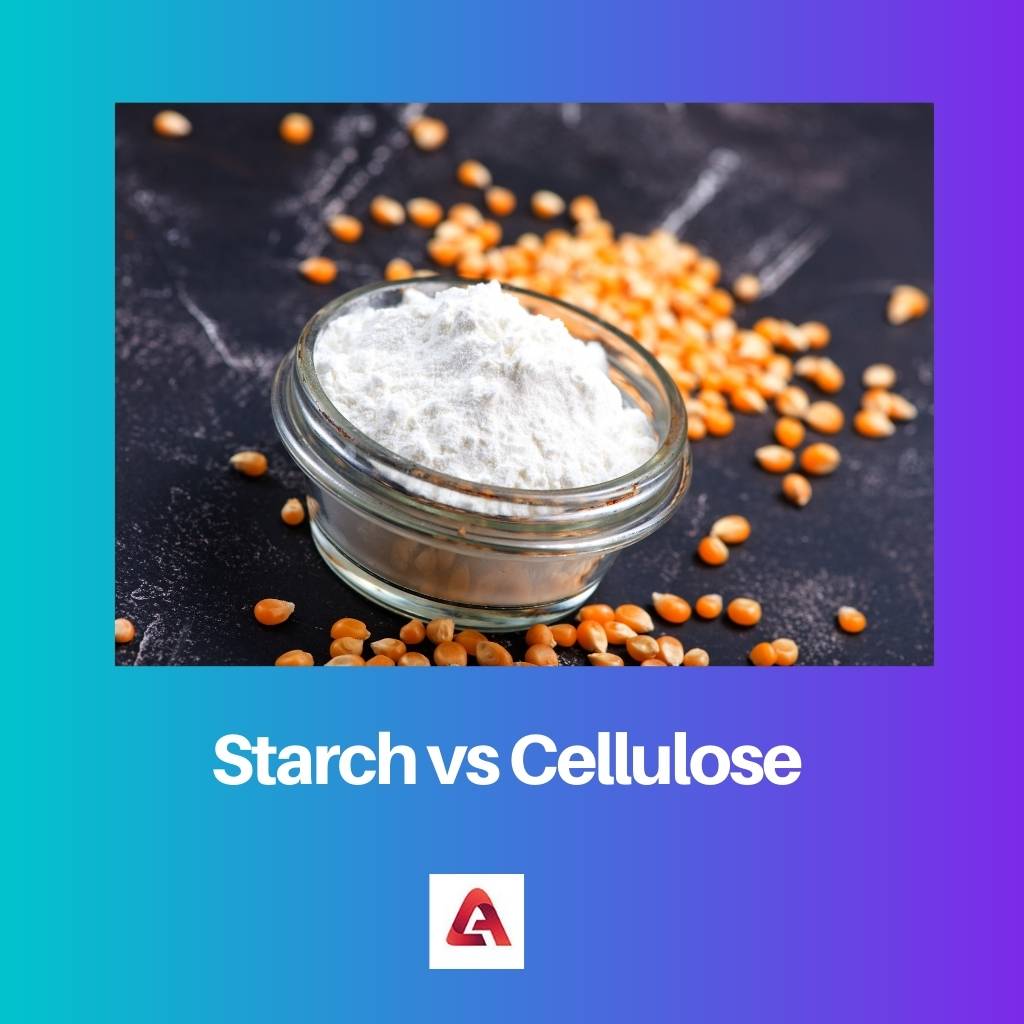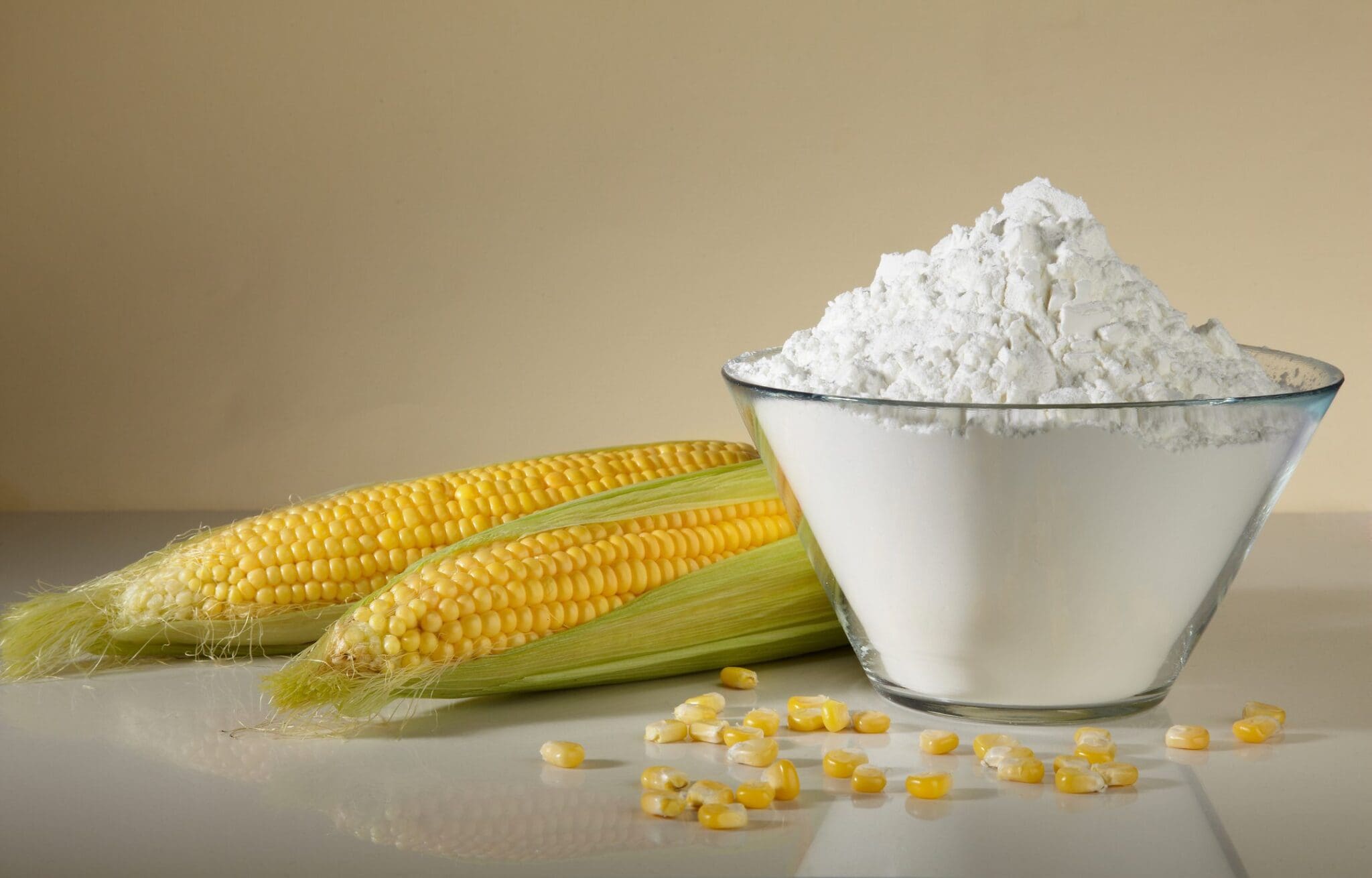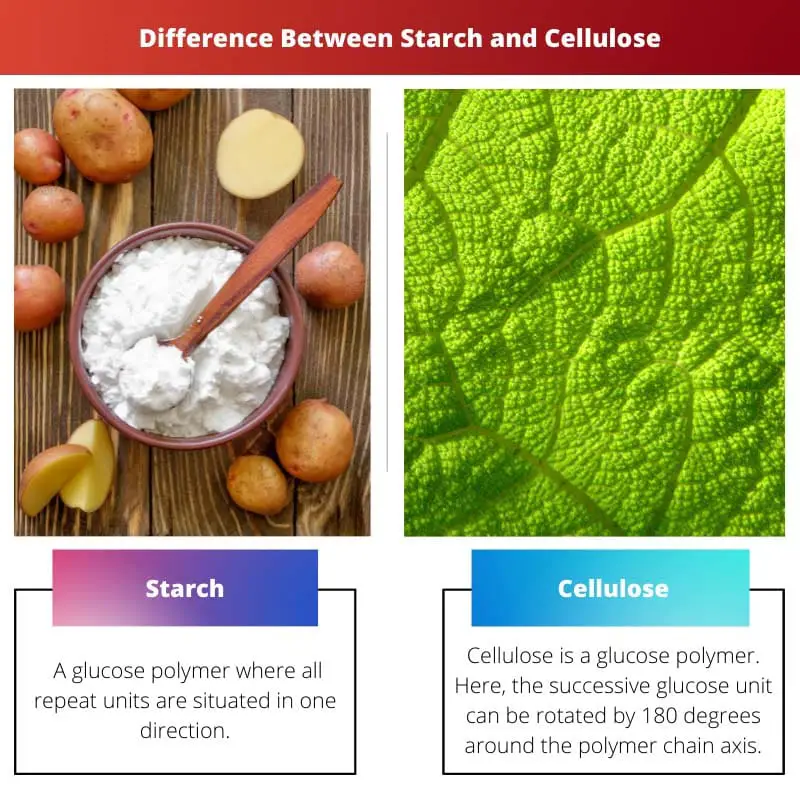Starch and Cellulose are both identical polymers having the same repeat units. These repeat units are dependent on glucose and are mainly composed of the same glucose and monomer.
Though both Starch and Cellulose have a lot of similar characteristics, they differ from each other in many aspects.
Key Takeaways
- Starch is a carbohydrate used for energy storage in plants and animals, while cellulose is used for plant structural support.
- Starch is broken down by enzymes in the digestive system, while cellulose is not digestible by humans.
- Starch is commonly found in foods like potatoes and rice, while cellulose is found in celery and lettuce.
Starch vs Cellulose
The difference between Starch and Cellulose is that in Starch, the glucose repeat units are all situated in the same direction, whereas in Cellulose, each glucose unit is rotated by 180 degrees around the polymer chain axis.

Starch is a glucose polymer where all repeat units are situated in one direction. The units are connected by alpha bonds. Starch is edible because we have enzymes that can break it down into glucose.
This is further safely used and can be eaten by human beings. Starch is a carbohydrate, and people get their Starch and carbohydrate mainly from potatoes, wheat, and corn.
Cellulose is a glucose polymer where each successive glucose unit can be rotated around the axis of the backbone polymer chain. These units are connected internally by beta chains.
Cellulose is not edible and cannot be consumed by human beings. The human body does have enzymes, but these enzymes cannot break Cellulose into glucose. However, some animals like cows, and termites can break them and consume them.
Comparison Table
| Parameters of Comparison | Starch | Cellulose |
|---|---|---|
| Definition | A glucose polymer where all repeat units are situated in one direction | Cellulose is a glucose polymer. Here, the successive glucose unit can be rotated by 180 degrees around the polymer chain axis. |
| Consumption | Starch is edible and can be consumed by human beings. | Cellulose cannot be consumed by human beings. It can only be consumed by certain animals like cows and termites. |
| Linkage | Units are linked by Alpha bonds. | Units are linked internally by Beta links. |
| Water-Soluble | Can be dissolved in warm water. | Does not dissolve in water. |
| Strength | Starch is weaker than Cellulose. | Cellulose is a lot stronger than starch. |
| Usage | Starch is mainly used by plants to store energy. | Cellulose is mainly used by plants to support the structure. |
| Digestion | Starch is easily digestible. | Cellulose is difficult to digest. |
What is Starch?
Starch is a glucose polymer where all repeat units are situated in one direction. The units are connected by alpha bonds. Starch is edible and can be consumed by human beings.
This is because the human body has enzymes that have the capability of breaking down Starch into glucose, which can further be eaten and used safely by human beings.
Starch is weaker than Cellulose. It can only be dissolved in warm water. Starch is also less crystalline than Cellulose. Starch is easy to digest and is used by plants to store energy.
Starch is a carbohydrate. People get their supply of Starch and carbohydrates from potatoes, wheat, and rice. Starch can also be used in the treatment of paper, like glue, and to thicken sauces.

What is Cellulose?
Cellulose is a glucose polymer. Here, the successive glucose unit can be rotated by 180 degrees around the polymer chain axis. These units are connected internally by beta chains.
Although some forms of Cellulose, like the outer shell of corn, can be consumed by human beings, Cellulose is not edible.
The enzymes in the human body cannot break into glucose, and they can only be consumed by animals like cows and termites.
Cellulose is stronger than Starch. Unlike Starch, Cellulose cannot be dissolved in water. Cellulose can only be broken down into glucose while treating it in acid at high temperatures.
Cellulose is more crystalline than Starch. Cellulose is difficult to digest and is used by the plant to support the structure.
Cellulose mostly has commercial uses, like being the main component of paper and fibre, making cellophane and rayon, and many others.

Main Differences Between Starch and Cellulose
- Starch is a glucose polymer where all repeat units are situated in one direction, whereas Cellulose is a glucose polymer where the glucose units can be rotated by 180 degrees around the polymer chain axis.
- The units in Starch are linked by Alpha bonds, whereas in Cellulose it is linked by Beta links.
- Starch is edible and can be consumed by human beings, whereas Cellulose is not edible and cannot be consumed by human beings. It can only be consumed by certain animals like cows and termites.
- Starch is weaker than Cellulose, whereas Cellulose is a lot stronger than Starch.
- Starch can be dissolved in warm water, whereas Cellulose cannot be dissolved in water.
- Starch is used by plants to store energy, whereas Cellulose is used by plants to support the structure.
- Starch is less crystalline than Cellulose, whereas Cellulose is more crystalline.
- Starch can be obtained from potatoes, wheat and can also be used as glue, whereas Cellulose can only be used for commercial purposes like being the main component in paper and fibre.

- https://www.sciencedirect.com/science/article/abs/pii/S0003267003010705
- https://journals.sagepub.com/doi/abs/10.1177/0731684414558325

This article is indeed informative. Starch and Cellulose are both very important glucose polymers.
Absolutely! I appreciate how the article noted that the human body can break down starch into glucose, but not cellulose. It’s an interesting contrast.
The distinctions between starch and cellulose are effectively presented in this article. It’s quite insightful to understand how similar molecular compositions lead to diverse properties and applications.
The comparison table is very helpful in understanding the differences. It’s impressive how starch and cellulose, despite being composed of the same glucose units, have such different properties.
Absolutely, Kanderson. The information about the consumption and digestion differences between starch and cellulose is particularly intriguing.
I agree. Understanding the composition and properties of these polymers is essential in various fields including nutrition, agriculture, and materials science.
This article is an excellent resource for understanding the fundamental differences between starch and cellulose. The practical implications are far-reaching and significant.
Indeed, Jonathan Reynolds. The articulation of differences in digestion, solubility, and uses is extremely valuable.
Absolutely, Jonathan Reynolds. The information provided here enhances our knowledge of the diverse applications of starch and cellulose.
The article provides a comprehensive overview of the differences. I appreciate how it describes the specific uses and applications of both starch and cellulose.
Absolutely. The clear differentiation between starch and cellulose has practical implications in a variety of domains.
Yes, Gavin. Understanding the distinct properties and applications is invaluable in industries such as food, paper, and textiles.
The article effectively conveys the key differences between starch and cellulose. It’s impressive how a minor difference in the arrangement of glucose units leads to such diverse properties.
Indeed, Hshaw. It’s fascinating how small variations in molecular structure can have such significant effects in real-world applications.
The distinctions between starch and cellulose have been articulated exceptionally well. The information in this article is crucial for understanding the diverse roles played by these polymers.
Absolutely, Adam77. The insights provided here are foundational to understanding the role of starch and cellulose in nature and human applications.
Agreed, Adam77. From food science to materials engineering, the distinctions between starch and cellulose are vital for various industries.
I appreciate the comprehensive examination of starch and cellulose. The article effectively captures the unique features of these glucose polymers.
Absolutely, Edwards Joshua. The detailed explanations enhance our understanding of the vital distinctions between starch and cellulose.
The detailed description of starch and cellulose is impressive. It’s fascinating to learn about the structural and functional disparities between these polymers.
Absolutely, the information provided here is a testament to the complex nature of these glucose polymers.
Indeed, Lloyd. The unique features of starch and cellulose contribute to their importance in multiple aspects of human life and industry.
The article effectively highlights the distinctions between starch and cellulose. The practical applications of understanding these differences are immense.
I completely agree, Matilda25. This article provides a solid foundation for understanding the unique properties of starch and cellulose.
Absolutely, Matilda25. Moreover, it emphasizes the significance of these glucose polymers in various sectors.